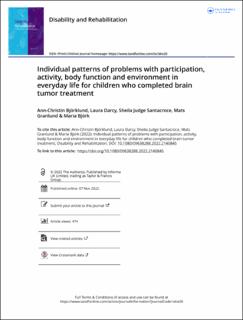| dc.contributor.author | Björklund, Ann-Christin | |
| dc.contributor.author | Darcy, Laura | |
| dc.contributor.author | Santacroce, Sheila Judge | |
| dc.contributor.author | Granlund, Mats | |
| dc.contributor.author | Björk, Maria | |
| dc.date.accessioned | 2023-05-15T13:00:56Z | |
| dc.date.available | 2023-05-15T13:00:56Z | |
| dc.date.created | 2022-11-28T13:22:03Z | |
| dc.date.issued | 2022 | |
| dc.identifier.citation | Disability and Rehabilitation. 2022, . | en_US |
| dc.identifier.issn | 0963-8288 | |
| dc.identifier.uri | https://hdl.handle.net/11250/3067962 | |
| dc.description.abstract | Purpose
The study purpose was to, with the help of ICF and the CPS model, describe and explain patterns of co-occurring problems with participation in everyday life activities, body functioning and environment for children who completed brain tumor treatment.
Materials and methods
Hospital, habilitation and school records for nine children (5–11 yrs.) diagnosed with brain tumor, were retrospectively reviewed for everyday problems after treatment completion. These problems were linked to ICF codes. Median code distribution within ICF constructs participation, body function, body structure, activity, and environment were calculated to generate typical (close to median) and atypical (distant from median) patterns of problems on individual and group levels. Two children were in-depth analyzed with collaborative problem-solving (CPS) model to identify participation problems and plausible explanations.
Results
In total, 4543 ICF linked codes revealed similarities and differences between individuals. The selected child-cases displayed educational challenges and peer-relational problems. The ICF codes related to activity, body function and environment revealed plausible explanations for the children’s documented problems with participation in everyday life.
Conclusions
The combination of ICF and CPS can provide a comprehensive view of the child’s problems and guide development of participation in everyday life-focused interventions for children treated for brain tumors.
Implications for rehabilitation
Care should be guided by interventions and support directed at individual children and their everyday life.
The International Classification of Functioning, Disability and Health (ICF) framework can support identification of the individual child’s patterns of problems and how these affects the child’s everyday life.
It is recommended to start by identifying participation problems when using ICF to identify and describe problems in children’s natural settings.
The collaborative problem-solving model can guide healthcare, habilitation and school services when identifying and acting on typical and atypical problem patterns experienced by these children. | en_US |
| dc.language.iso | eng | en_US |
| dc.publisher | Taylor & Francis | en_US |
| dc.rights | Attribution-NonCommercial-NoDerivatives 4.0 Internasjonal | * |
| dc.rights.uri | http://creativecommons.org/licenses/by-nc-nd/4.0/deed.no | * |
| dc.title | Individual patterns of problems with participation, activity, body function and environment in everyday life for children who completed brain tumor treatment | en_US |
| dc.title.alternative | Individual patterns of problems with participation, activity, body function and environment in everyday life for children who completed brain tumor treatment | en_US |
| dc.type | Peer reviewed | en_US |
| dc.type | Journal article | en_US |
| dc.description.version | publishedVersion | en_US |
| dc.source.pagenumber | 11 | en_US |
| dc.source.journal | Disability and Rehabilitation | en_US |
| dc.identifier.doi | 10.1080/09638288.2022.2140845 | |
| dc.identifier.cristin | 2082639 | |
| cristin.ispublished | true | |
| cristin.fulltext | original | |
| cristin.qualitycode | 1 | |

